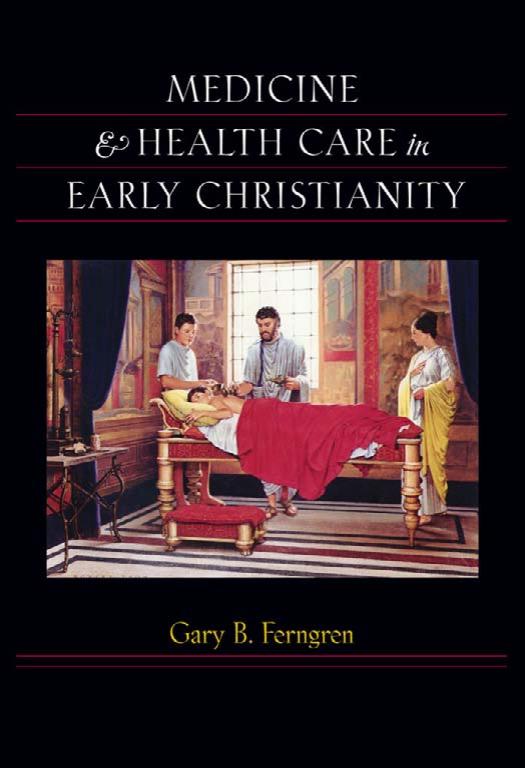Medicine and Health Care in Early Christianity by Gary B. Ferngren

Author:Gary B. Ferngren
Language: eng
Format: epub, mobi, pdf
Publisher: Johns Hopkins University Press
Published: 2009-03-11T04:00:00+00:00
Spoudaioi and Philoponoi
Not as well known as the parabalani, but more widespread, were the lay orders of spoudaioi and philoponoi, which were to be found in the cities of the Eastern Roman Empire in late antiquity and the Byzantine period. The spoudaioi were “the zealous ones”; in Egypt they were known as philoponoi, “lovers of labor.” They formed groups that were attached to large churches in the great cities of the East: Alexandria, Antioch, Constantinople, Beirut, and Jerusalem, most prominently, although they are attested for smaller cities as well.126 The spoudaioi comprised both lay men and women who adopted ascetic practices that included chastity (or continence for those who were married) and fasting. Their functions varied somewhat according to local traditions, but in most cities their ministry was twofold: to care for the sick and to perform liturgical functions, such as reading scripture, chanting, praying, and participating in funerals, vigils, and processions.127 While they represented a branch of the ascetic movement, they never constituted a monastic order and so stood apart from both the anchoritic and cenobitic traditions.128 Although laypeople, they came to be recognized as an intermediate order between the clergy and the laity, and they are so described by several sources.129 Our earliest reference to the spoudaioi is found in a letter written in the year 312 by the patriarch of Alexandria, who mentions them in the context of the years 303–5. We find frequent mention of them from the fourth through the seventh centuries and a few scattered references thereafter.130
Our sources indicate that a chief function of the spoudaioi was to provide assistance to the indigent sick of the urban areas in which they lived. Already in the Hippocratic Corpus we find reference to the homeless sick who populated the streets of Greek cities in the fifth century B.C. While widely removed in time from late antiquity, they provide a vivid picture of social conditions that did not change in essentials over many centuries.131 Several cases are recorded in the Epidemics (which was probably written about 400 B.C.): a girl in Abdera, who lay sick by the Sacred Way for twenty-seven days; Anaxion of Abdera, who lay sick of acute fever by the Thracian Gate for thirty-four days; the wife of Delearces in Thasos, who lay sick on the plain with acute fever and mental disturbance.132 In many instances, as one often finds in the Epidemics, those whose conditions are described died after a specified number of days. The fact that they remained uncared for in public places suggests that they were without resources and were either set out to die or had no family or friends to care for them. A well-known biblical example is the narrative in the Fourth Gospel (Jn. 5:3–4) of Jesus’s healing of a man who had been paralyzed for thirty-eight years. He lay at the pool of Bethesda, situated near the Sheep Gate in Jerusalem, which had five porches around it. Those who were blind, lame, or paralyzed gathered there, waiting
Download
Medicine and Health Care in Early Christianity by Gary B. Ferngren.mobi
Medicine and Health Care in Early Christianity by Gary B. Ferngren.pdf
This site does not store any files on its server. We only index and link to content provided by other sites. Please contact the content providers to delete copyright contents if any and email us, we'll remove relevant links or contents immediately.
The Gnostic Gospels by Pagels Elaine(2459)
Jesus by Paul Johnson(2294)
Devil, The by Almond Philip C(2266)
The Nativity by Geza Vermes(2165)
The Psychedelic Gospels: The Secret History of Hallucinogens in Christianity by Jerry B. Brown(2112)
Forensics by Val McDermid(2030)
Going Clear: Scientology, Hollywood, and the Prison of Belief by Lawrence Wright(1925)
Going Clear by Lawrence Wright(1910)
Barking to the Choir by Gregory Boyle(1773)
Old Testament History by John H. Sailhamer(1757)
Augustine: Conversions to Confessions by Robin Lane Fox(1727)
The Early Centuries - Byzantium 01 by John Julius Norwich(1688)
A Prophet with Honor by William C. Martin(1672)
A History of the Franks by Gregory of Tours(1670)
Dark Mysteries of the Vatican by H. Paul Jeffers(1660)
The Bible Doesn't Say That by Dr. Joel M. Hoffman(1640)
by Christianity & Islam(1585)
The First Crusade by Thomas Asbridge(1567)
The Amish by Steven M. Nolt(1523)
